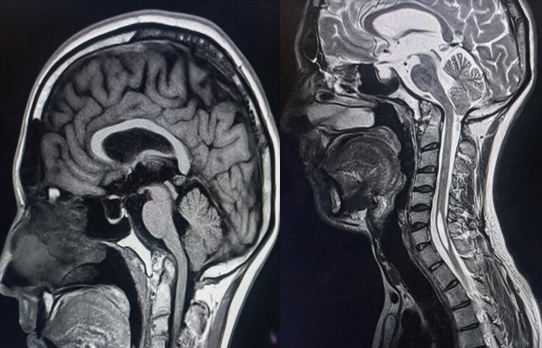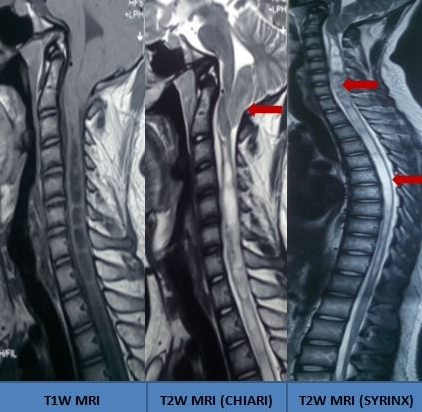[1]
Greitz D. Unraveling the riddle of syringomyelia. Neurosurgical review. 2006 Oct:29(4):251-63; discussion 264
[PubMed PMID: 16752160]
[2]
Milhorat TH, Chou MW, Trinidad EM, Kula RW, Mandell M, Wolpert C, Speer MC. Chiari I malformation redefined: clinical and radiographic findings for 364 symptomatic patients. Neurosurgery. 1999 May:44(5):1005-17
[PubMed PMID: 10232534]
[3]
Roy AK, Slimack NP, Ganju A. Idiopathic syringomyelia: retrospective case series, comprehensive review, and update on management. Neurosurgical focus. 2011 Dec:31(6):E15. doi: 10.3171/2011.9.FOCUS11198. Epub
[PubMed PMID: 22133183]
Level 2 (mid-level) evidence
[4]
Klekamp J, Batzdorf U, Samii M, Bothe HW. Treatment of syringomyelia associated with arachnoid scarring caused by arachnoiditis or trauma. Journal of neurosurgery. 1997 Feb:86(2):233-40
[PubMed PMID: 9010425]
[5]
Roser F, Ebner FH, Sixt C, Hagen JM, Tatagiba MS. Defining the line between hydromyelia and syringomyelia. A differentiation is possible based on electrophysiological and magnetic resonance imaging studies. Acta neurochirurgica. 2010 Feb:152(2):213-9; discussion 219. doi: 10.1007/s00701-009-0427-x. Epub 2009 Jun 16
[PubMed PMID: 19533016]
[6]
Bogdanov EI, Mendelevich EG. Syrinx size and duration of symptoms predict the pace of progressive myelopathy: retrospective analysis of 103 unoperated cases with craniocervical junction malformations and syringomyelia. Clinical neurology and neurosurgery. 2002 May:104(2):90-7
[PubMed PMID: 11932037]
Level 2 (mid-level) evidence
[7]
Mampalam TJ, Andrews BT, Gelb D, Ferriero D, Pitts LH. Presentation of type I Chiari malformation after head trauma. Neurosurgery. 1988 Dec:23(6):760-2
[PubMed PMID: 3216976]
[9]
Sixt C, Riether F, Will BE, Tatagiba MS, Roser F. Evaluation of quality of life parameters in patients who have syringomyelia. Journal of clinical neuroscience : official journal of the Neurosurgical Society of Australasia. 2009 Dec:16(12):1599-603. doi: 10.1016/j.jocn.2009.04.019. Epub 2009 Oct 8
[PubMed PMID: 19818628]
Level 2 (mid-level) evidence
[10]
Weier K, Naegelin Y, Thoeni A, Hirsch JG, Kappos L, Steinbrich W, Radue EW, Gass A. Non-communicating syringomyelia: a feature of spinal cord involvement in multiple sclerosis. Brain : a journal of neurology. 2008 Jul:131(Pt 7):1776-82. doi: 10.1093/brain/awn068. Epub 2008 May 31
[PubMed PMID: 18515871]
[11]
Brickell KL, Anderson NE, Charleston AJ, Hope JK, Bok AP, Barber PA. Ethnic differences in syringomyelia in New Zealand. Journal of neurology, neurosurgery, and psychiatry. 2006 Aug:77(8):989-91
[PubMed PMID: 16549414]
[12]
Speer MC, Enterline DS, Mehltretter L, Hammock P, Joseph J, Dickerson M, Ellenbogen RG, Milhorat TH, Hauser MA, George TM. Review Article: Chiari Type I Malformation with or Without Syringomyelia: Prevalence and Genetics. Journal of genetic counseling. 2003 Aug:12(4):297-311. doi: 10.1023/A:1023948921381. Epub
[PubMed PMID: 26141174]
[13]
GARDNER WJ, ANGEL J. The mechanism of syringomyelia and its surgical correction. Clinical neurosurgery. 1958:6():131-40
[PubMed PMID: 13826542]
[15]
Williams B. On the pathogenesis of syringomyelia: a review. Journal of the Royal Society of Medicine. 1980 Nov:73(11):798-806
[PubMed PMID: 7017117]
[16]
Oldfield EH, Muraszko K, Shawker TH, Patronas NJ. Pathophysiology of syringomyelia associated with Chiari I malformation of the cerebellar tonsils. Implications for diagnosis and treatment. Journal of neurosurgery. 1994 Jan:80(1):3-15
[PubMed PMID: 8271018]
[17]
Milhorat TH, Miller JI, Johnson WD, Adler DE, Heger IM. Anatomical basis of syringomyelia occurring with hindbrain lesions. Neurosurgery. 1993 May:32(5):748-54; discussion 754
[PubMed PMID: 8492850]
[18]
Honey CM, Martin KW, Heran MKS. Syringomyelia Fluid Dynamics and Cord Motion Revealed by Serendipitous Null Point Artifacts during Cine MRI. AJNR. American journal of neuroradiology. 2017 Sep:38(9):1845-1847. doi: 10.3174/ajnr.A5328. Epub 2017 Jul 27
[PubMed PMID: 28751514]
[19]
Ball MJ, Dayan AD. Pathogenesis of syringomyelia. Lancet (London, England). 1972 Oct 14:2(7781):799-801
[PubMed PMID: 4116236]
[20]
Oldfield EH. Pathogenesis of Chiari I - Pathophysiology of Syringomyelia: Implications for Therapy: A Summary of 3 Decades of Clinical Research. Neurosurgery. 2017 Sep 1:64(CN_suppl_1):66-77. doi: 10.1093/neuros/nyx377. Epub
[PubMed PMID: 28899066]
[21]
Koyanagi I, Houkin K. Pathogenesis of syringomyelia associated with Chiari type 1 malformation: review of evidences and proposal of a new hypothesis. Neurosurgical review. 2010 Jul:33(3):271-84; discussion 284-5. doi: 10.1007/s10143-010-0266-5. Epub 2010 Jun 8
[PubMed PMID: 20532585]
[22]
Weig SG, Buckthal PE, Choi SK, Zellem RT. Recurrent syncope as the presenting symptom of Arnold-Chiari malformation. Neurology. 1991 Oct:41(10):1673-4
[PubMed PMID: 1922816]
[23]
Batzdorf U, Khoo LT, McArthur DL. Observations on spine deformity and syringomyelia. Neurosurgery. 2007 Aug:61(2):370-7; discussion 377-8
[PubMed PMID: 17762750]
[24]
Milhorat TH, Mu HT, LaMotte CC, Milhorat AT. Distribution of substance P in the spinal cord of patients with syringomyelia. Journal of neurosurgery. 1996 Jun:84(6):992-8
[PubMed PMID: 8847594]
[25]
Grant R, Hadley DM, Macpherson P, Condon B, Patterson J, Bone I, Teasdale GN. Syringomyelia: cyst measurement by magnetic resonance imaging and comparison with symptoms, signs and disability. Journal of neurology, neurosurgery, and psychiatry. 1987 Aug:50(8):1008-14
[PubMed PMID: 3655805]
[26]
Fujii K, Natori Y, Nakagaki H, Fukui M. Management of syringomyelia associated with Chiari malformation: comparative study of syrinx size and symptoms by magnetic resonance imaging. Surgical neurology. 1991 Oct:36(4):281-5
[PubMed PMID: 1948628]
Level 2 (mid-level) evidence
[27]
Goel A, Desai K. Surgery for syringomyelia: an analysis based on 163 surgical cases. Acta neurochirurgica. 2000:142(3):293-301; discussion 301-2
[PubMed PMID: 10819260]
Level 3 (low-level) evidence
[28]
Mauer UM, Freude G, Danz B, Kunz U. Cardiac-gated phase-contrast magnetic resonance imaging of cerebrospinal fluid flow in the diagnosis of idiopathic syringomyelia. Neurosurgery. 2008 Dec:63(6):1139-44; discussion 1144. doi: 10.1227/01.NEU.0000334411.93870.45. Epub
[PubMed PMID: 19057326]
[29]
Dyste GN, Menezes AH, VanGilder JC. Symptomatic Chiari malformations. An analysis of presentation, management, and long-term outcome. Journal of neurosurgery. 1989 Aug:71(2):159-68
[PubMed PMID: 2746341]
[30]
Attal N, Parker F, Tadié M, Aghakani N, Bouhassira D. Effects of surgery on the sensory deficits of syringomyelia and predictors of outcome: a long term prospective study. Journal of neurology, neurosurgery, and psychiatry. 2004 Jul:75(7):1025-30
[PubMed PMID: 15201364]
[31]
Lee TT, Alameda GJ, Camilo E, Green BA. Surgical treatment of post-traumatic myelopathy associated with syringomyelia. Spine. 2001 Dec 15:26(24 Suppl):S119-27
[PubMed PMID: 11805618]
[32]
Hida K, Iwasaki Y, Koyanagi I, Sawamura Y, Abe H. Surgical indication and results of foramen magnum decompression versus syringosubarachnoid shunting for syringomyelia associated with Chiari I malformation. Neurosurgery. 1995 Oct:37(4):673-8; discussion 678-9
[PubMed PMID: 8559295]
[33]
Grant R, Hadley DM, Lang D, Condon B, Johnston R, Bone I, Teasdale GM. MRI measurement of syrinx size before and after operation. Journal of neurology, neurosurgery, and psychiatry. 1987 Dec:50(12):1685-7
[PubMed PMID: 3437304]
[34]
Logue V, Edwards MR. Syringomyelia and its surgical treatment--an analysis of 75 patients. Journal of neurology, neurosurgery, and psychiatry. 1981 Apr:44(4):273-84
[PubMed PMID: 7241155]
[35]
Bleck TP, Shannon KM. Disordered swallowing due to a syrinx: correction by shunting. Neurology. 1984 Nov:34(11):1497-8
[PubMed PMID: 6493500]
[36]
Muhonen MG, Menezes AH, Sawin PD, Weinstein SL. Scoliosis in pediatric Chiari malformations without myelodysplasia. Journal of neurosurgery. 1992 Jul:77(1):69-77
[PubMed PMID: 1607974]
[37]
Watson NF, Buchwald D, Goldberg J, Maravilla KR, Noonan C, Guan Q, Ellenbogen RG. Is Chiari I malformation associated with fibromyalgia? Neurosurgery. 2011 Feb:68(2):443-8; discussion 448-9. doi: 10.1227/NEU.0b013e3182039a31. Epub
[PubMed PMID: 21135714]
[38]
Mueller DM, Oro' JJ. Prospective analysis of presenting symptoms among 265 patients with radiographic evidence of Chiari malformation type I with or without syringomyelia. Journal of the American Academy of Nurse Practitioners. 2004 Mar:16(3):134-8
[PubMed PMID: 15130068]



